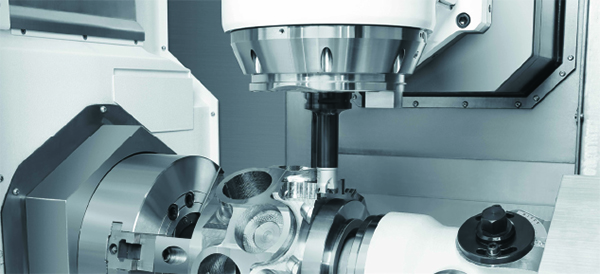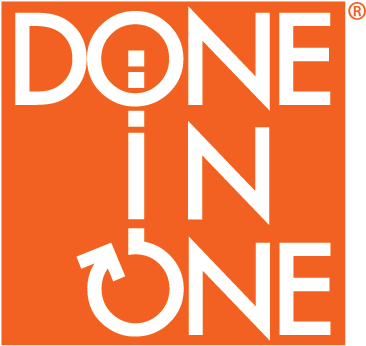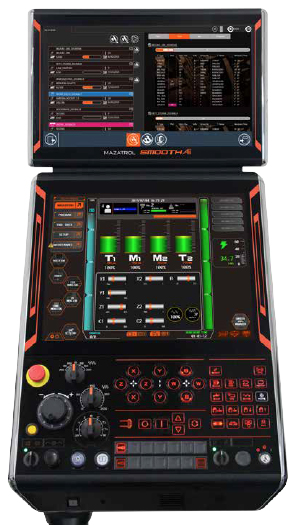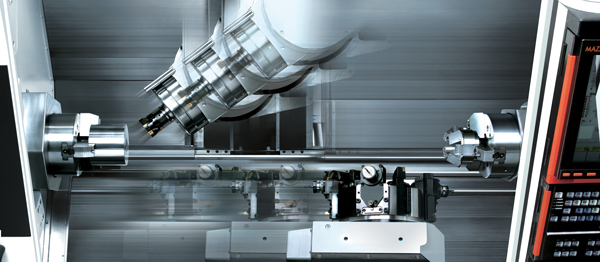With high-mix/low-volume production, just-in-time inventories and increasingly demanding customers, manufacturers require the single-setup efficiency of Multi-Tasking – and for the industry’s widest range of capabilities, manufacturers go with the Multi-Tasking pioneers at Mazak.
The Progression of Multi-Tasking Machine Tool Technology
Multi-Tasking machine tools have revolutionized manufacturing and continue to play a critical role in today’s progressive manufacturing facilities. In addition to enabling incredible gains in productivity, Multi-Tasking technology has catapulted manufacturers, especially smaller ones, to levels where they can easily and cost-effectively machine the world’s most complex parts.
Since the concept’s inception, Multi-Tasking machine configurations have progressed from early systems that combined simple milling and turning operations to advanced machine tools like Mazak Corporation’s INTEGREX Series of machines, which incorporate such advanced components and capabilities as twin turning spindles, multiple tool turrets with rotary tool stations and Y-axis off-centerline machining, tilt/rotary B-axis milling spindles, rotary/tilt tables, large capacity tool magazines, and full simultaneous 5-axis part processing. However, Multi-Tasking technology development has far from leveled off, and machine tool builders such as Mazak have continued to refine and improve upon the designs of Multi-Tasking machines.
As one builder that has recently worked to further advance the Multi-Tasking concept, Mazak has introduced HYBRID Multi-Tasking, which combines additive – including direct metal laser sintering and Hot Wire Deposition (HWD) – with subtractive manufacturing operations. It also combines conventional machining with joining capabilities such as Friction Stir Welding (FSW) and specialty operations like gear cutting with Auto Gear (AG). Such HYBRID systems catapult Mazak’s Multi-Tasking DONE IN ONE part processing concept to the next level of single-machine production.
Benefits of Multi-Tasking
Multi-Tasking machines mill, turn and drill part features with high accuracy and precision, but most importantly for manufacturers, they also significantly reduce job setup time with their ability to perform most, if not all, of a workpiece’s required machining in one cycle. Additionally, the combination of operations achieved with a Multi-Tasking machine dramatically reduces the risk of inaccuracies that occur when workpieces travel across multiple workstations, as well as eliminates work-in-process (WIP) inventory that might otherwise wait between standalone machine tools.
Without the need to transfer workpieces from one machine to the next, Multi-Tasking machines require minimal human intervention and can operate unattended for longer periods of time. They allow manufacturers to accomplish more with fewer machine tools on their factory floors, which saves valuable production space. Fewer required machines, in turn, results in lower production costs and shorter job turnaround times.
Early drivers of Multi-Tasking

Three key technological developments fueled the accelerated development of the Multi-Tasking concept. Those developments were integral motors, controllers/computers with increased processing power and CAD/CAM software.
Higher power controllers allowed manufacturers to maintain data points across milling and turning operations within the same workpiece setup on a Multi-Tasking machine. This increased repeatability and eliminated the risk of human error when workpieces had to move from one single-process machine to the next. And as controllers became even more powerful, they also helped simplify program generation for Multi-Tasking machines, performing more computations to efficiently handle additional machine axes. The controls also gave manufacturers the ability to program parts from solid CAD models to further simplify programming the complex tool paths needed for Multi-Tasking machines.
As controls became more powerful, Mazak incorporated even more machine axes and spindles within each Multi-Tasking machine platform. However, traditional belt drives tended to hinder the performance and positioning accuracy of those additional spindles – until the development of integral motor technology.
Electric motors that fully encase the machine spindle, integral motors initially delivered speeds up to 5,000 rpm and positioning accuracies within 1 degree. In addition to improving the spindle’s ability to stop and position accurately, integral spindle motors introduced the ability to perform complex contours with C-axis turning spindles. For milling spindles, the technology introduced B-axis control to the spindle along with higher rpm and horsepower. And today, this technology enables speeds over 20,000 rpm and positioning accuracies that reach 0.001 degrees.
Following the introduction of integral spindle motors, Mazak experimented with the use of worm wheels for further performance improvements, but the design had backlash issues. Instead, Mazak developed a highly capable roller cam design, and it currently has begun exploring the use of direct drive technology for milling spindle headstocks on Mazak Multi-Tasking machines. For its vertical Multi-Tasking machine platform, roller cam technology paved the way for Mazak’s tilt/rotary tables and full, simultaneous 5-axis machining.
Mazak’s DONE IN ONE Concept

From the start of its Multi-Tasking machine development process, Mazak strived for completing parts in one setup: A solid raw piece of material enters the Multi-Tasking machine and a completed component exits. The company achieved this goal with its DONE IN ONE part-processing concept.
The introduction of lower turrets is what allowed for DONE IN ONE and simultaneous part processing, meaning the machine’s upper turret is working on a part in the machine’s main spindle while the lower turret works on another part in the second spindle. This configuration resulted in significantly shorter part cycle times and higher machining accuracy along with increased capacity, flexibility and productivity – all with one machine. DONE IN ONE also contributes to reduced cost per part because fewer workholding fixtures and tooling are required.
However, not all Multi-Tasking machines have DONE IN ONE capabilities. Some may offer milling and turning but are unable to fully process all sides of a part in a single clamping. For this capability, the machine must be able to reposition a workpiece in such a way as to allow the machine access to all of the required surfaces. A perfect example of this is a twin turning spindle Multi-Tasking machine that can process one end of a part in its main spindle then hand it off to the second spindle to complete the remainder of the surfaces.
Five levels of Multi-Tasking
As Mazak produced more models of Multi-Tasking machines with a wide range of part-processing abilities, the company developed its “5 Levels of Multi-Tasking” guidelines to ensure manufacturers could match their specific part-processing needs to the appropriate level of Multi-Tasking machine. Each of the five levels describes the particular Multi-Tasking machine capabilities and features thatcan range from turrets with rotating tool spindles to dedicated milling head stocks and tool magazines to additive manufacturing.
- Level 1 machines typically feature a single turning spindle and a drum-style turret with rotating tool capabilities for simple turning, milling, drilling and tapping operations.
- Level 2 introduces Y-axis off-centerline machining with a machine’s drum turret for an expanded range of potential part geometries. Machines at this level also perform DONE IN ONE machining through the use of dual spindles with a milling turret or a two-turret configuration.
- Level 3 encompasses machines with independent milling headstocks that have B-axis indexing for 4-axis simultaneous machining and 5-axis tool tip positioning. They also feature full Y-axis travels and tool storage magazines.
- Level 4 machines provide full simultaneous 5-axis machining and emphasize the use of automation for processing large and highly complex parts. Several machines within this level may be easily integrated with robots, while
others pair perfectly with Mazak’s multi-pallet PALLETECH System for fully automated, unattended production. - Level 5 is represented by Mazak’s highly advanced HYBRID Multi-Tasking technology. For this level, the company equips machines from Level 4 with powerful additive and joining functions or specialized application-specific technologies such as Hot Wire Deposition (HWD) or laser deposition additive manufacturing, Friction Stir Welding (FSW), and the Auto Gear (AG) gear cutting solutions. All of these technologies enable manufacturers to machine the most demanding and complex parts in a single setup and to automate their operations with Mazak’s PALLETECH System or its MAZATROL SMS for unattended production.
Mazatrol Smooth Controls

In the early days of Multi-Tasking, one of the main reasons manufacturers were slow to embrace it was because of the lengthy learning curves involved with the technology. Most machinists at that time specialized in either milling or turning, and Multi-Tasking basically required those individuals to collaborate to successfully use the technology and shorten the learning curves involved. To help speed this process up, Mazak developed MAZATROL conversational programming in 1981 and set a precedent in CNC technology.
This proprietary programming language provides both versatility and ease of use, allowing manufacturers to program Mazak machines using either conversational or EIA/ISO programming. And, over the last three decades, Mazak has continued to enhance this programming language to enable virtually infinite part-production capabilities.
Even the most advanced programming language and strategy will fail to provide part-processing benefits on older controls, however – without sufficient processing power, machine spindles must wait between movements for the control to read the next line of code. After developing MAZATROL, Mazak increased the computing power of its controls with the SMOOTH TECHNOLOGY software suite and a series of MAZATROL Smooth CNCs.
These powerful controls have the processing power necessary for advanced look-ahead functionality, a feature that is crucial for the speed and smoothness of machine movement during Multi-Tasking part processing.
Within its SMOOTH TECHNOLOGY platform, the MAZATROL SmoothG, SmoothX and SmoothAi CNCs feature robust processing speeds and computing power to ensure ease of use as well as high-speed, high-accuracy machining.
- The MAZATROL SmoothG CNC offers easy programming for processing complex parts through off-centerline machining as well as angled drilling, milling and tapping.
- The MAZATROL SmoothX CNC is one of Mazak’s fastest, most progressive CNCs, bringing extreme productivity advantages to the most demanding machining operations. It ensures the shortest possible machining cycle times, especially in fine increment programs for simultaneous 5-axis operations and free-form die-mold machining.
- The new MAZATROL SmoothAi CNC introduces advanced digital innovations to the machining process for programming as well as monitoring functions for machines’ spindle conditions and thermal stability. The control makes operational setups faster and easier through automatic MAZATROL programming directly from 3D CAD data. And with a variety of artificial intelligence (AI) and machine learning capabilities, the control can predict suitable machining processes through a database constructed from a manufacturer’s past operations.
The future of Multi-Tasking

Mazak continues to develop highly productive combinations of machining strategies within its HYBRID Multi-Tasking concept. These combinations include laser metal deposition and Hot Wire Deposition (HWD) additive manufacturing processes or joining techniques such as Friction Stir Welding (FSW) together with traditional subtractive machining. The company has also combined Multi-Tasking with other specialized operations, including the Mazak Auto Gear (AG) package, which utilizes Mazak’s SMOOTH Gear Cutting software solutions for DONE IN ONE gear manufacturing.
For one of its additive and subtractive combinations, Mazak developed HWD technology in collaboration with Lincoln Electric. The process uses heating elements within a wire additive manufacturing head to heat wire that is then extruded and melted to grow part features, which are then machined to size via conventional subtractive operations. The HWD process offers exceptional material stability in addition to one of the fastest methods for building metal parts in modern manufacturing.
In conjunction with Mazak MegaStir, Mazak combined subtractive machining and FSW joining processes on a single Multi-Tasking machine platform. Such a machine not only improves part accuracy, it also significantly expands
the use cases of traditional welding. FSW produces joints with minimal defects and has the ability to join dissimilar materials, all while significantly reducing the heat-affected zones produced by traditional welding.
Finally, to streamline gear production, Mazak developed its Auto Gear (AG) technology, which offers all the necessary capabilities for machining gears in a DONE IN ONE Multi-Tasking machine platform. Along with Mazak’s specialized SMOOTH Gear Cutting software, the machine eliminates the complexities and challenges of gear machining on a Multi-Tasking system. As a result, advanced gear-making applications no longer require 3D models or CAD/CAM programming steps; instead, workpiece parameters are entered via a conversational dashboard interface and the software creates the necessary machine instructions, which enables shorter setups and the use of commercial off-the-shelf tooling for dramatically reduced part-processing times.
Conclusion
Mazak continues to prove itself as a pioneer in Multi-Tasking technology, and as a result, the company has developed over 200 different machine models capable of multiple operations in a single machine platform. These machines allow today’s manufacturers to process virtually any type of workpiece with one Mazak Multi-Tasking machine – and the number of parts suitable for DONE IN ONE processing has expanded with the rise of HYBRID Multi-Tasking. With these systems, manufacturers, especially smaller ones, gain the versatility, agility and productivity they need to succeed in a constantly changing manufacturing world.
